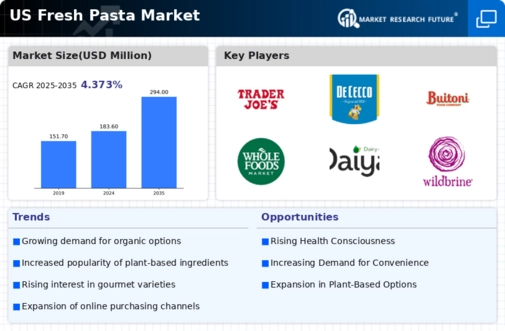The fresh pasta market exhibits a dynamic competitive landscape characterized by a blend of traditional craftsmanship and modern innovation. Key players such as Barilla (IT), De Cecco (IT), and Rana (IT) are at the forefront, each employing distinct strategies to capture market share. Barilla (IT) focuses on expanding its product range to include organic and gluten-free options, appealing to health-conscious consumers. De Cecco (IT) emphasizes quality and authenticity, leveraging its heritage to differentiate its offerings. Rana (IT) has adopted a strategy of regional expansion, particularly in the U.S. market, where it seeks to enhance its presence through partnerships with local distributors. Collectively, these strategies foster a competitive environment that prioritizes quality, innovation, and consumer preferences.
In terms of business tactics, companies are increasingly localizing manufacturing to reduce supply chain vulnerabilities and enhance responsiveness to market demands. The competitive structure of the fresh pasta market appears moderately fragmented, with several key players holding substantial market shares while also allowing room for smaller, niche brands. This fragmentation encourages innovation and diverse product offerings, as companies strive to meet the varied tastes and preferences of consumers.
In October 2025, Barilla (IT) announced a new initiative aimed at reducing its carbon footprint by 30% by 2030, which underscores its commitment to sustainability. This strategic move not only aligns with growing consumer demand for environmentally friendly products but also positions Barilla (IT) as a leader in sustainable practices within the industry. Such initiatives are likely to resonate with eco-conscious consumers, potentially enhancing brand loyalty and market share.
In September 2025, Rana (IT) launched a new line of fresh pasta infused with superfoods, targeting health-oriented consumers. This product innovation reflects a broader trend towards health and wellness in food choices. By integrating superfoods into its offerings, Rana (IT) not only diversifies its product line but also taps into a lucrative market segment that prioritizes nutritional value, thereby enhancing its competitive edge.
In August 2025, De Cecco (IT) expanded its distribution network in the U.S. by partnering with a major grocery chain, significantly increasing its market penetration. This strategic alliance is indicative of a broader trend where companies seek to enhance their distribution capabilities to reach a wider audience. Such partnerships are crucial for driving sales and brand visibility in a competitive landscape.
As of November 2025, the fresh pasta market is increasingly influenced by trends such as digitalization, sustainability, and the integration of artificial intelligence in production processes. Companies are leveraging technology to optimize operations and enhance customer engagement. Strategic alliances are becoming more prevalent, allowing firms to pool resources and expertise to navigate the complexities of the market. Looking ahead, competitive differentiation is likely to evolve from traditional price-based strategies to a focus on innovation, technological advancements, and supply chain reliability, as companies strive to meet the ever-changing demands of consumers.




















Leave a Comment